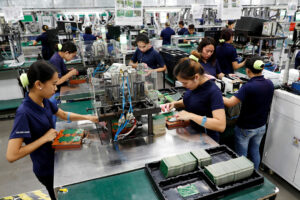August factory output drops on electronics, food
FACTORY OUTPUT dropped to a four-month low in August due to slower growth in electronics and food manufacturing, according to the Philippine Statistics Authority (PSA).

By Beatriz Marie D. Cruz, Reporter
FACTORY OUTPUT dropped to a four-month low in August due to slower growth in electronics and food manufacturing, according to the Philippine Statistics Authority (PSA).
Preliminary results of the agency’s Monthly Integrated Survey of Selected Industries (MISSI) showed factory production, as measured by the volume of production index (VoPI), slowed to 2.8% year on year from 6.8% in July and 5.6% a year earlier.
This was also the lowest annual growth in the manufacturing sector since 1.4% in April, PSA data showed.
Month on month, the manufacturing sector’s VoPI fell by 0.9% from the 3.9% uptick in July. Stripping out seasonality factors, factory output dropped by 7.6% in August from 10.5% a month earlier.
This brought the average manufacturing output growth for the eight-month period to 1.7%, slower than 5.4% in 2023.
In comparison, S&P Global’s Philippine Manufacturing Purchasing Managers’ Index (PMI) rose to 53.7 in September from 51.2 in August. It was the fastest PMI recorded since 53.8 in June 2022.
A PMI reading above 50 indicates improved operating conditions, while a reading below 50 shows the opposite.
The year-on-year decline in manufacturing was mainly driven by the slower annual increase in the manufacture of food products, with a 0.6% annual increase from 13.1% in the previous month.
Also contributing to the slow growth in factory activity were the slower yearly increases in the manufacture of computer, electronic and optical products at 4.2% from 13.2% in July, and coke and refined petroleum products at 15.5% from 20.4%.
Of the 19 industry divisions, 13 posted year-on-year increases in August, led by coke and refined petroleum products; beverages (12.8% from 12.2%); and computer, electronic and optical products (4.2% from 13.2%).
Meanwhile, six industry divisions posted annual declines, led by the manufacture of basic metals — 3.2% in August from a 9.4% drop in July. Chemical and chemical products fell by 3.6% and other manufacturing and repair and installation of machinery and equipment dropped by 10.3%.
August’s capacity utilization rate, or the extent at which industry resources are used in producing goods, averaged 75.5%, lower than 75.7% in July.
All industry divisions reported capacity utilization rates of more than 60% during the month.
The top three industry divisions with the highest capacity utilization rates were the manufacture of textiles (82.2%), nonmetallic mineral products (82%) and manufacture of machinery and equipment except electrical (82%).
The slow factory activity in August was due to the lagged effects of inflation and supply chain constraints in the past months, Paolo R. Rivera, a research fellow at the Philippine Institute for Development Studies, said in a Viber message.
“Low demand due to inflation can also explain it, as well as the prevailing unemployment at that time, constraining production,” he added.
Inflation has averaged 3.6% as of end-August. Manufacturing slowed in August amid typhoons and the impact of the ghost months on consumer behavior, Michael L. Ricafort, chief economist at Rizal Commercial Banking Corp., said in a Viber message.
Slower growth in the US and China, two of the Philippines’ major trading partners, also affected factory activity, he added.
The Philippine central bank’s 25-basis-point cut in August, which is expected to be followed by a series of rate cuts this quarter, could help reduce manufacturers’ borrowing and financing costs, Mr. Ricafort said.
BSP Governor Eli M. Remolona, Jr. last week said the Monetary Board could deliver a 25-bp rate cut at its two remaining meetings this year.
















